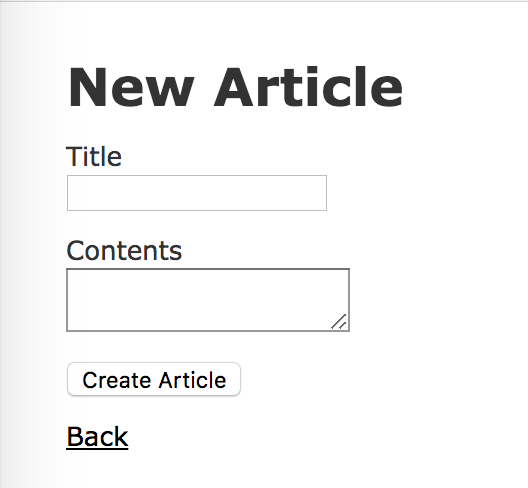一連の記事の目次
rails、君に決めた!!~目次
前回の記事
rails君に決めた!!~2
アプリケーション開発
やっと開発編に入れる〜
ルーター
役割
ユーザーのリクエストをコントローラーのアクションと結びつける
これはあとで意味がじんわりわかる系なのでとりあえずこれだけで飛ばそう。
REST
REpresentational State Transferの略。
定義
* リソースは一意に特定できる
* ステートレスである
* URLはリソースの複数形で表す
* URLには動詞を含めず、HTTPメソッドで操作を指定する
うーん。。なんとなくしかわからない。
Railsではリソースはモデルとして表現する。
リソースは何かしらの機能を抽象的に理解したものなのかな。
ステートレスは「過去の注文を覚えてられない店員さん」って何かの本に書いてあった。
RESTに基づくルーティングの作成
実際にやってみよう!
bin/rails g scaffold user name:string email:string
bin/rails g scaffold article title:string contents:text
データベースのスキーマ定義をデータベースに反映
bin/rails db:migrate
scaffoldコマンドで、指定したリソース(user,articleなど)に対するモデル、ビュー、コントローラ、ルーティングの雛形を一度に生成できる。
ここら辺はDjangoより圧倒的に便利だなー。
scaffold: 足場
定義されたルーティングの確認
bin/rails routes
Prefix Verb URI Pattern Controller#Action
articles GET /articles(.:format) articles#index
POST /articles(.:format) articles#create
new_article GET /articles/new(.:format) articles#new
edit_article GET /articles/:id/edit(.:format) articles#edit
article GET /articles/:id(.:format) articles#show
PATCH /articles/:id(.:format) articles#update
PUT /articles/:id(.:format) articles#update
DELETE /articles/:id(.:format) articles#destroy
users GET /users(.:format) users#index
POST /users(.:format) users#create
new_user GET /users/new(.:format) users#new
edit_user GET /users/:id/edit(.:format) users#edit
user GET /users/:id(.:format) users#show
PATCH /users/:id(.:format) users#update
PUT /users/:id(.:format) users#update
DELETE /users/:id(.:format) users#destroy
home_index GET /home/index(.:format) home#index
一行目を解釈してみる。
/articlesというURLにGETでアクセスすると、articles_controllerのindexアクションにルーティングされるよ、Prefix(Rails内で参照できる名前付きのルート)はarticlesだよ、となる。
Prefixが無いルートにもasオプションで名前をつけられる
だってさ、安心。
prefix: 接頭辞
1つのリソースに対して生成されたパスは8種類、重複してるupdateを除くと7種類のアクションが生成されている。URLは重複を除くと4種類生成されている。
7種のアクションを表でまとめてみる。
| HTTPメソッド | パス | アクション | 目的 |
|---|---|---|---|
| GET | /articles | index | articleの一覧を取得 |
| POST | /articles | create | articleを作成 |
| GET | /articles/new | new | articleを作成するためのformを取得 |
| GET | /articles/:id | edit | 特定のarticleを編集するためのformを取得 |
| GET | /articles/:id | show | 特定のarticleを一つ取得 |
| PUT/PATCH | /articles/:id | update | 特定のarticleを更新 |
| DELETE | /articles/:id | delete | 特定のarticleを削除 |
この表だけですごく勉強になる!fmfmという感じ笑
PUT :リソースそのものの更新
PATCH:リソースの部分置換
試しにサーバーを起動してhttp://localhost:3000/articles/newにアクセスしてみると

できとる!!
Djangoでここまで来るの結構大変だぞ...Railsすごい
config/routes.rb内にルーティングが定義されている。
Railsルーターの基本的なメソッド
- resources
resources :articles
resources :articles, only: [:index, :show]
こんな感じで書くと、リソースに対するルーティングを生成してくれる。
:onlyとか:exceptを使うと、有効にするアクションを絞ることができる、、。
機能とURLをいい感じに対応させてくれるって程度の理解でいいのかな
- resource
resourcesと違い、:idなどを持たないルーティングを生成。例えば、設定系のルーティングであれば、ログインしているユーザーidによって処理を分けるので、設定リソースのidは必要ない
ごめん、分からないww。ブログの記事とかだと1ユーザーに複数記事あるけど、設定画面とかは1ユーザー1つだから、設定idなくてもユーザーidあればいいよね?みたいな感じか??うん、きっとそうだと信じて進む。
- get/post/patch/put/delete
ヘルプページなど、GETリクエストだけ受け付ければいいような、ほぼ静的なリソースを扱いたいとき使う
Rails.application.routes.draw do
# ...
get '/help', to: 'static_pages#help'
end
StaticPagesControllerのhelpアクションにルーティングされる。
ルーティングをもうちょっと細かく作ってみる
config/routes.rb
Rails.application.routes.draw do
resources :articles
resources :users
get 'home/index'
# 追加
get '/hello', to: 'application#hello'
end
/helloというURLにGETリクエストでアクセスすると、ApplicationControllerのhelloアクションを呼び出す、というルーティングを追加した。
app/controllers/application_controller.rbにhelloアクションを実装
class ApplicationController < ActionController::Base
protect_from_forgery with: :exception
# 追加
def hello
text = 'Hello World!'
render plain: text
end
end
bin/rails sしてhttp://localhost:3000/helloにアクセスすると確認できた!
名前付きルート
Railsのアプリケーションから参照できる変数のようなルート名
get '/world', to: 'static_pages#world', as: 'foo'
のようにasを使ってエイリアスを作る。
名前付きルートを設定すると
名前付きルート_url
名前付きルート_path
という2つの名前付きヘルパーが使えるようになるらしい。
使ってみる。
$ bin/rails c
Loading development environment (Rails 5.1.5)
[1] pry(main)> app.new_article_path
=> "/articles/new"
[2] pry(main)> app.new_article_url
=> "http://www.example.com/articles/new"
~_url:絶対URL
~_path:相対パス
基本的にはpathを使った方がいいらしい。
パラメータの割り当て
URLの中に変数を埋め込む的な意味かな。
例えば
get 'users/@:user_name', to:'users#index', as:'user'
のように定義すると、
$ bin/rails c
Loading development environment (Rails 5.1.5)
[1] pry(main)> app.user_path(user_name: 'alice')
=> "/users/@alice"
変数名'alice'をURLに混ぜることができた。
今回は丸々ルータについてになっちゃったな
次回はコントローラー、セッション管理あたりをやろう